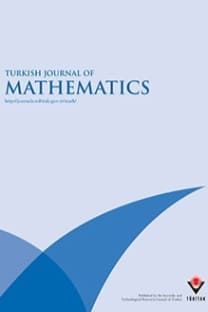Fibonacci and Lucas numbers as products of two repdigits
Fibonacci and Lucas numbers as products of two repdigits
___
- [1] Adegbindin C, Luca F, Togbé A. Pell and Pell-Lucas numbers as sums of two repdigits. Bulletin of the Malaysian Mathematical Sciences Society (in press). doi: 10.1007/s40840-019-00739-3
- [2] Alvarado SD, Luca F. Fibonacci numbers which are sums of two repdigits. Aportaciones Matemáticas Investigación 2011; 20: 97-108.
- [3] Baker A, Davenport H. The equations 3x2 − 2 = y2 and 8x2 − 7 = z2. Quarterly Journal of Mathematics Oxford Series 1969; 20 (1): 129-137.
- [4] Bugeaud Y, Mignotte M, Siksek S. Classical and modular approaches to exponential Diophantine equations I. Fibonacci and Lucas perfect powers. Annals of Mathematics 2006; 163 (3): 969-1018.
- [5] Ddamulira M, Luca F, Rakotomalala M. Fibonacci numbers which are products of two Pell numbers. Fibonacci Quarterly 2016; 54 (1): 11-18.
- [6] de Weger BMM. Algorithms for Diophantine equations. PhD, Eindhoven University of Technology, Eindhoven, the Netherlands, 1989.
- [7] Debnath L. A short history of the Fibonacci and golden numbers with their applications. International Journal of Mathematical Education in Science and Technology 2011; 42 (3): 337-367.
- [8] Dujella A, Pethò A. A generalization of a theorem of Baker and Davenport. Quarterly Journal of Mathematics and Oxford Series 1998; 49 (3): 291-306.
- [9] Faye B, Luca F. Pell and Pell-Lucas numbers with only one distinct digit. Annales Mathematicae et Informaticae 2015; 45: 55-60.
- [10] Luca F. Fibonacci and Lucas numbers with only one distinct digit. Portugaliae Mathematica 2000; 57 (2): 243-254.
- [11] Matveev EM. An explicit lower bound for a homogeneous rational linear form in the logarithms of algebraic numbers II. Izvestiya Akademii Nauk Series Mathematics 2000; 64 (6): 125-180 (in Russian).
- ISSN: 1300-0098
- Yayın Aralığı: 6
- Yayıncı: TÜBİTAK
Spectral analysis of some classes first-order normal differential operators
Automorphisms of free metabelian Leibniz algebras of rank three
Tuba TAŞ ADIYAMAN, Zeynep ÖZKURT
On nonoscillatory solutions of three dimensional time-scale systems
Özkan ÖZTÜRK, İsmail U. TİRYAKİ, Elvan AKIN, Taher HASSAN
Urtzi BUIJS, Antonio GARVIN, Aniceto MURILLO
On the cover ideals of chordal graphs
Approximation by generalized complex Szász–Mirakyan operators in compact disks
